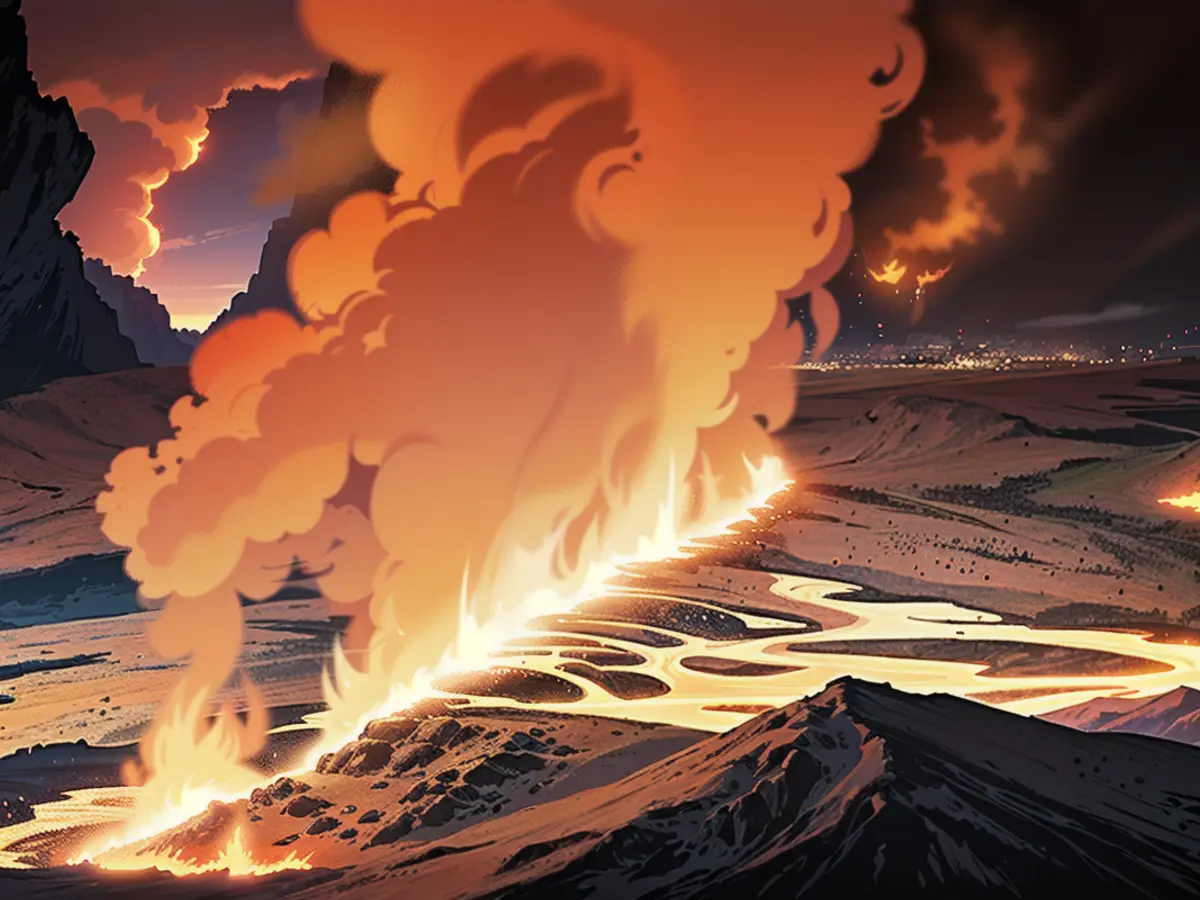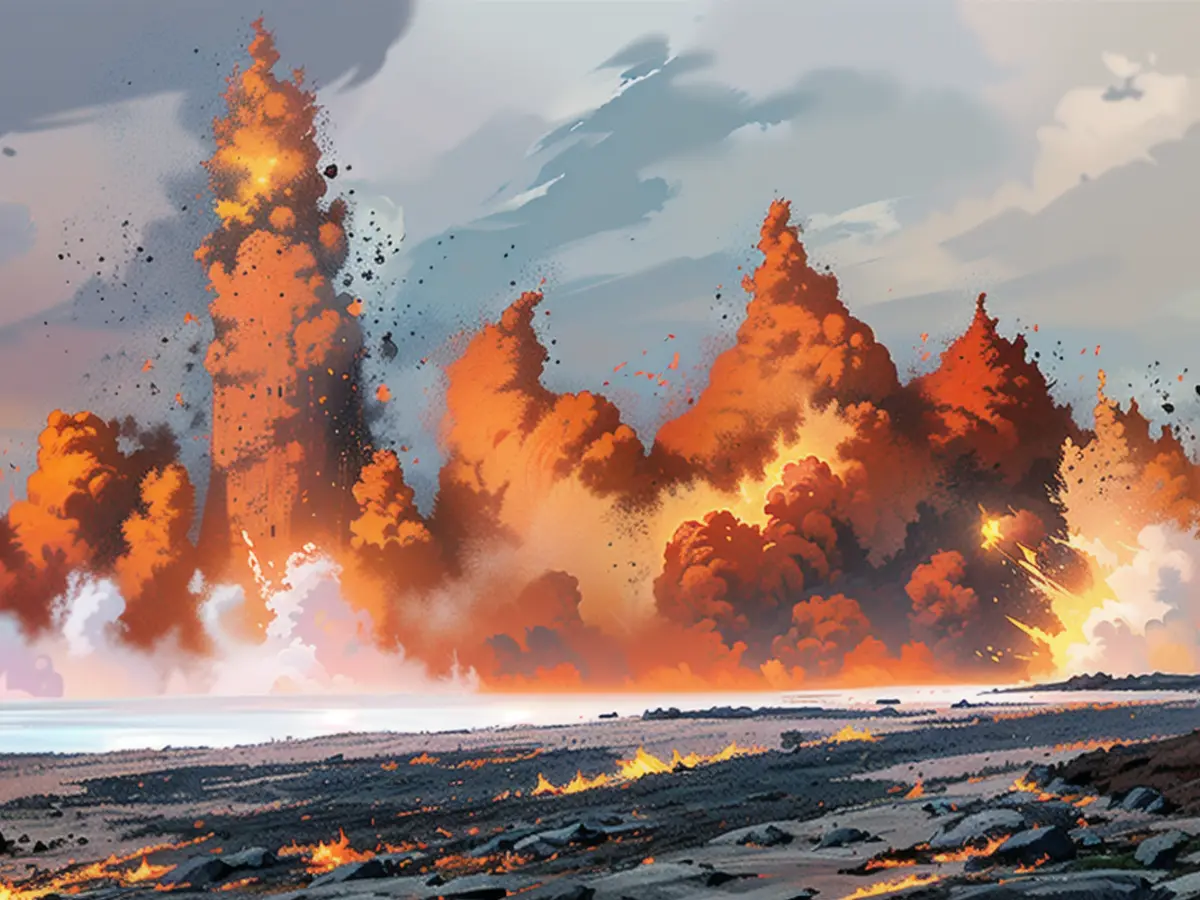Icelandic volcano erupts - A wall of fire: volcanic lava erupts to a height of 50 meters from a fissure within the ground.
Here, a massive surge of bright-orange molten lava is spewing out of the ground near the town of Grindavik in Iceland. This is accompanied by large plumes of smoke. From a distance, it resembles a forest fire, but upon closer inspection, it's a massive gush of lava spouting from an open fissure which occurred on a Wednesday. This isn't too far from Sundhnúk. There've been no casualties as everyone was evacuated from the area before the eruption occurred.
The glowing substance is advancing towards Grindavík, and also heading further west and north, according to Icelandic broadcaster RUV. This is the fifth time since December that the earth has split on the island. The fissure's initial length is estimated to be up to 3.4 kilometers, with a tendency to lengthen. Geophysicist Kristín Jónsdóttir from the Icelandic Meteorological Office said, "The earth has opened with great intensity." Professor Rikke Pedersen from the Nordic Volcanology Center at the University of Iceland described the lava as a "curtain of fire," spanning 2.5 km.
Iceland: Volcanic Eruption Feared
Professionals had sensed the magma eruption in their measurements, as the pressure below the ground was immense. Jónsdóttir stated that this is a more potent eruption because more magma has gathered than in earlier incidents. "We've been anticipating this eruption for some time. It's a relief that it occurred now." The eruption had started earlier than 11:00 a.m. (local time 13:00 p.m.). By midday, around 1000 cubic meters of lava per second were ejected from the fissure - about the capacity of a standard swimming pool.
Benedikt Ófeigsson of the Icelandic Meteorological Office reported that the lava primarily flowed towards the west. It was uncertain if the fissure and lava would reach the defenses surrounding Grindavík. Authorities had already started constructing contingency dikes months ago to redirect possible lava flows away from homes and essential infrastructure.
Ófeigsson explained that the eruption had lasted longer than anticipated, which could indicate the magma's increased difficulty in forcing its way up and breaching. The latest eruption burst through previous craters that were active during other eruptions. The fissure evolved in multiple directions.
Familiar and Threatening
Hours beforehand, authorities had ordered the evacuation of Grindavík's townspeople, as well as the well-known tourist spot, the Blue Lagoon (a thermal spa). Around 700-800 visitors were at the Blue Lagoon on Wednesday morning. Following the eruption, the authorities declared a state of emergency. The Civil Protection Authority requested people to steer clear of the eruption's location. Some onlookers had already arrived at the site. The volcanic event hadn't impacted air traffic thus far, in spite of the smoke.
Grindavík resides on the Reykjanes Peninsula - around 55 kilometers southwest of Reykjavik. During a January eruption, lava affected three houses on the northern edge of the 4000-resident town of Grindavík. The fate of this community haunted by volcanic activity is uncertain. The government has put forward a bill that would permit residents to sell their land to a state-owned entity.

Read also:
- Floods: water levels remain critical in many places
- Snow chaos further restricts Bavaria
- Continuous operation in the flood areas
- Flood situation remains tense in many places
- The headlines in Science & Technology sections around the world are now featuring the ongoing volcanic eruption at the Blue Lagoon in Iceland.
- Despite the distance, the volcanic fissure and its resulting lava curtains have started to pose a potential threat to the famous thermal spa, attracting global attention.
- Tourists visiting the Blue Lagoon on the day of the volcanic eruption had to be evacuated, as the event caused a state of emergency in the area.
- As the lava from the Reykjanes volcano continues to flow towards Grindavik, many are concerned about its impact on the nearby top news item, the Blue Lagoon, a major tourist attraction in Iceland.
- The current lava flow from the volcano has reached a height of 50 meters, painting the sky with a spectacle of fiery curtains, reminiscent of the infamous 'Curtain Call' of Iceland's volcanic past.
- Experts are closely monitoring developments in the Blue Lagoon and the surrounding area, as the volcanic activity in Iceland's Reykjanes Peninsula can contribute to the volcanic phenomenon commonly known as the 'Blue Lagoon," causing a spectacular sight but significant potential harm to the environment and local communities.
Source:






